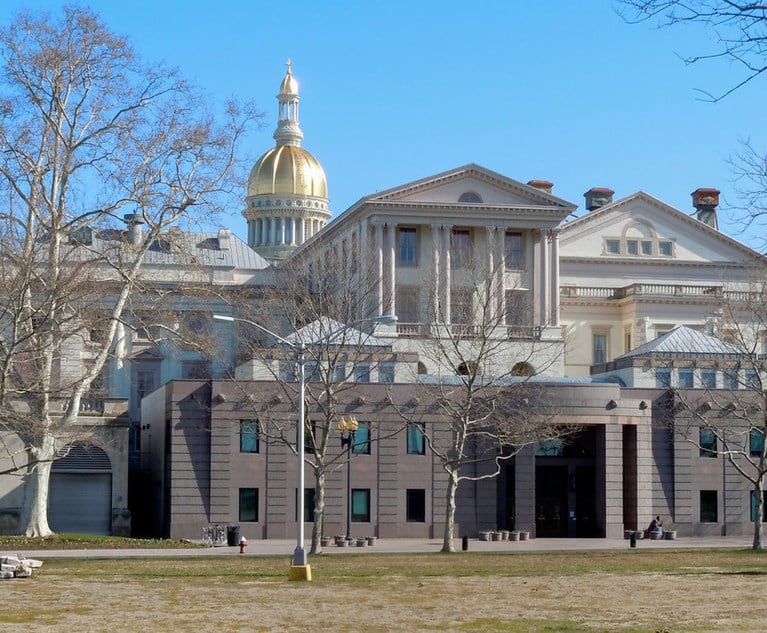Litigators of the Week: Beating Gerrymandering in Pennsylvania With Data
A team of lawyers from the Public Interest Law Center in Philadelphia and Arnold & Porter Kaye Scholer persuaded Pennsylvania's high court to strike down the state's congressional map, which favored Republicans. The impact could be huge.
January 25, 2018 at 06:32 PM
5 minute read

Gerrymandering is one of those topics that can get the blood boiling in most voters. But to defeat the practice in Pennsylvania, a team of lawyers took a more dispassionate approach—laying out the numbers before the state's highest court to show that Pennsylvania's congressional voting districts were horribly skewed in favor of one party.
On Jan. 22, the Pennsylvania Supreme Court ruled 5-2 in League of Women Voters of Pennsylvania v. Commonwealth of Pennsylvania that the Congressional Redistricting Act of 2011 was unconstitutional—a victory for the Democratic voters who challenged the Republican-controlled legislature's current districting layout.
The impact goes beyond Pennsylvania. It could potentially tip the scales in 2018, as Democrats make a bid to retake the House of Representatives in Washington, D.C.
The team behind the historic decision was a coalition of attorneys from the Public Interest Law Center in Philadelphia and Arnold & Porter Kaye Scholer in Washington, D.C., who also worked together in 2012 to strike down Pennsylvania's voter ID law.
Mimi McKenzie, the legal director of the Public Interest Law Center, and David Gersch, who led the Arnold & Porter pro bono team in the litigation, said computer models, maps, dates and common sense are what won the day in their representation of the League of Women Voters.
And in a stroke of poetic justice, the same tools state lawmakers used to draw maps in their favor were used against them in the court room.
“Advancements in technology, in mapping software, being able to load data into mapping software—all of that allows parties in control to carefully engineer maps to their advantage,” McKenzie said, adding that “the very technology that allows legislators to gerrymander, also helps us detect partisan gerrymandering.”
The team used data from three separate election cycles to provide evidence of gerrymandering, showing that Republicans win the same 13 districts to the Democrats' five every time.
“The Republicans have this 13-5 built-in advantage in the way that the map is drawn, and that has held even though there are natural swings in the vote from election to election,” McKenzie said.
According to Gersch and McKenzie, one expert, University of Michigan political science professor Jowei Chen, used traditional redistricting criteria to randomly create a thousand maps, which compared to the current congressional map, shows the current map is an extreme outlier in terms of partisanship.
Another was Wesley Pegden of the Carnegie Mellon University's mathematics department. He employed the Markov chain analysis to the study of Pennsylvania's districts. He input the current congressional map into a computer program and made slight changes to the edges of the districts. The result is that when a precinct is slightly altered, the 13-5 advantage disappears, Gersch said.
“All these different metrics taken together is what allowed us to prove this map intentionally discriminates against those who vote Democratic,” McKenzie said.
And according to Gersch, the state Supreme Court seemed to recognize that from the beginning. Oral argument was simply a formality.
“I think they had largely decided the case in our favor on the briefs. The real question was on the remedy, the things that could be done,” Gersch said.
The remedy came swiftly. Days after argument, the Pennsylvania Supreme Court issued an order to the legislature for the immediate drafting of a new congressional map. If lawmakers and Gov. Tom Wolf failed to agree on a plan before mid-February, the court would come up with something itself.
Republican lawmakers were not enthused by the order and accused the majority-Democrat court of political gamesmanship.
The ruling “is a partisan action showing a distinct lack of respect for the constitution and the legislative process. The Pennsylvania Supreme Court has overstepped its legal authority and set up an impossible deadline that will only introduce chaos in the upcoming congressional election,” said a joint statement from Senate President Pro Tempore Joe Scarnati and Senate Majority Leader Jake Corman.
On Thursday, Republican lawmakers asked the U.S. Supreme Court to issue an emergency stay.
But Gersch and McKenzie said Scarnati was playing games of his own during the litigation.
“From the outset, we were met with nothing but delay from the legislative respondents,” McKenzie said of attempts to retrieve discovery from the defendants, as well as the legislators' motions for stays and bid to remove the litigation to federal court.
“I've never seen anything like this,” Gersch said.
In the end, though, Gersch said the collaboration and teamwork between to two firms helped carry the day. In addition to McKenzie and Gersch, the team consisted of Ben Geffen and Michael Churchill from the Public Interest Law Center and John Freedman, Dan Jacobson, Stanton Jones and Elisabeth Theodore from Arnold & Porter.
“We had a great team,” Gersch said. “This case was stayed until Nov. 9, we had to go to trial Nov. 11 and we were at the Supreme Court last week. We had to mount a very sophisticated case in a very short time.”
This content has been archived. It is available through our partners, LexisNexis® and Bloomberg Law.
To view this content, please continue to their sites.
Not a Lexis Subscriber?
Subscribe Now
Not a Bloomberg Law Subscriber?
Subscribe Now
NOT FOR REPRINT
© 2025 ALM Global, LLC, All Rights Reserved. Request academic re-use from www.copyright.com. All other uses, submit a request to [email protected]. For more information visit Asset & Logo Licensing.
You Might Like
View All
Should It Be Left to the Plaintiffs Bar to Enforce Judicial Privacy Laws?
7 minute read
A Reporter and a Mayor: Behind the Scenes During the Eric Adams Indictment News Cycle

Of Predictive Analytics and Robots: A First-Year Federal Judge's Thoughts on AI
Trending Stories
Who Got The Work
J. Brugh Lower of Gibbons has entered an appearance for industrial equipment supplier Devco Corporation in a pending trademark infringement lawsuit. The suit, accusing the defendant of selling knock-off Graco products, was filed Dec. 18 in New Jersey District Court by Rivkin Radler on behalf of Graco Inc. and Graco Minnesota. The case, assigned to U.S. District Judge Zahid N. Quraishi, is 3:24-cv-11294, Graco Inc. et al v. Devco Corporation.
Who Got The Work
Rebecca Maller-Stein and Kent A. Yalowitz of Arnold & Porter Kaye Scholer have entered their appearances for Hanaco Venture Capital and its executives, Lior Prosor and David Frankel, in a pending securities lawsuit. The action, filed on Dec. 24 in New York Southern District Court by Zell, Aron & Co. on behalf of Goldeneye Advisors, accuses the defendants of negligently and fraudulently managing the plaintiff's $1 million investment. The case, assigned to U.S. District Judge Vernon S. Broderick, is 1:24-cv-09918, Goldeneye Advisors, LLC v. Hanaco Venture Capital, Ltd. et al.
Who Got The Work
Attorneys from A&O Shearman has stepped in as defense counsel for Toronto-Dominion Bank and other defendants in a pending securities class action. The suit, filed Dec. 11 in New York Southern District Court by Bleichmar Fonti & Auld, accuses the defendants of concealing the bank's 'pervasive' deficiencies in regards to its compliance with the Bank Secrecy Act and the quality of its anti-money laundering controls. The case, assigned to U.S. District Judge Arun Subramanian, is 1:24-cv-09445, Gonzalez v. The Toronto-Dominion Bank et al.
Who Got The Work
Crown Castle International, a Pennsylvania company providing shared communications infrastructure, has turned to Luke D. Wolf of Gordon Rees Scully Mansukhani to fend off a pending breach-of-contract lawsuit. The court action, filed Nov. 25 in Michigan Eastern District Court by Hooper Hathaway PC on behalf of The Town Residences LLC, accuses Crown Castle of failing to transfer approximately $30,000 in utility payments from T-Mobile in breach of a roof-top lease and assignment agreement. The case, assigned to U.S. District Judge Susan K. Declercq, is 2:24-cv-13131, The Town Residences LLC v. T-Mobile US, Inc. et al.
Who Got The Work
Wilfred P. Coronato and Daniel M. Schwartz of McCarter & English have stepped in as defense counsel to Electrolux Home Products Inc. in a pending product liability lawsuit. The court action, filed Nov. 26 in New York Eastern District Court by Poulos Lopiccolo PC and Nagel Rice LLP on behalf of David Stern, alleges that the defendant's refrigerators’ drawers and shelving repeatedly break and fall apart within months after purchase. The case, assigned to U.S. District Judge Joan M. Azrack, is 2:24-cv-08204, Stern v. Electrolux Home Products, Inc.
Featured Firms
Law Offices of Gary Martin Hays & Associates, P.C.
(470) 294-1674
Law Offices of Mark E. Salomone
(857) 444-6468
Smith & Hassler
(713) 739-1250







